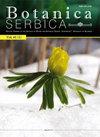讨论了石斛被珠的形成、大孢子发生和大孢子发生,并对胚囊类型和切片技术作了重点讨论
IF 1.1
4区 生物学
Q4 PLANT SCIENCES
引用次数: 0
摘要
对一种具有重要经济价值的兰花石斛的被珠形成、大孢子发生和巨孢子发生进行了观察。授粉后,胎盘表皮的有丝分裂细胞分裂导致分支系统的形成。每个分枝的尖端由一个由表皮下的终端核细胞分化而来的孢原细胞组成。它直接分化成大孢子细胞。大孢子母细胞减数分裂的第一次分裂产生大小大致相等的二分体,其中微孔细胞迅速退化。剩余的二分体细胞进行第二次减数分裂,形成两个大小不等的大孢子。较大的合点细胞开始发挥功能,并最终发育成成熟的巨生植物。大孢子植物的发育符合单孢子蓼型。成熟胚囊的最终排列符合七细胞/八核结构。成熟胚珠为双胚珠,具腱核,朝反。在本研究中,我们还讨论了三种主要类型的胚囊发育的差异和切片技术的改进。本文章由计算机程序翻译,如有差异,请以英文原文为准。
The formation of integuments, megasporogenesis and megagametogenesis in Dendrobium catenatum, with special discussions on embryo sac types and section techniques
The formation of integuments, megasporogenesis and megagametogenesis in Dendrobium catenatum, an economically important orchid, are observed. After pollination, mitotic cell divisions of the placental epidermis result in the formation of a branching system of outgrowths. The tip of each branch consists of an archesporial cell derived from the differentiation of the terminal subepidermal nucellar cell. It differentiates directly into a megasporocyte. The first division of the meiosis of the megasporocyte produces a dyad approximately equal in size, in which the micropylar cell promptly degenerates. The second meiotic division of the remaining dyad cell results in the formation of two megaspores of unequal size. The larger chalazal cell becomes functional and eventually develops into a mature megagametophyte. The development of the megagametophyte conforms to the Monosporic Polygonum type. The final arrangement of the mature embryo sac conforms to a sevencelled/ eight-nucleate structure. The mature ovule is bitegmic, tenuinucellate and has an anatropous orientation. In the present study, we also discuss the differences between three main types of embryo sac development and the improvement of section techniques.
求助全文
通过发布文献求助,成功后即可免费获取论文全文。
去求助
来源期刊

Botanica Serbica
Agricultural and Biological Sciences-Plant Science
CiteScore
1.40
自引率
12.50%
发文量
17
审稿时长
34 weeks
期刊介绍:
Botanica Serbica publishes original research papers on all aspects of plant, fungal and microbial biology research including the disciplines of microbiology, mycology, lichenology, bryology, flora, vegetation, biogeography, systematics, taxonomy, plant biotechnology, plant cell biology, plant ecology, environmental plant biology, forestry, genomics, horticulture, limnology, metabolomics, molecular biology, proteomics, virology, plant conservation and protection, and wildlife and ecosystem management.
 求助内容:
求助内容: 应助结果提醒方式:
应助结果提醒方式:


